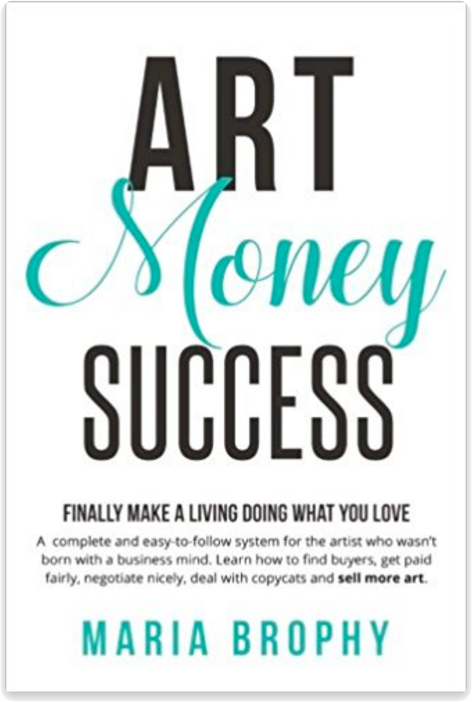 This is one of the questions I received from an artist:
This is one of the questions I received from an artist:
Is it okay to make and sell print reproductions of a painting that was commissioned by a collector?
My answer: Yes, absolutely! Selling print reproductions of your work is a smart business model that enables an artist to earn money again and again from one painting.
This works very much like a musical artist: They don’t sell a song to just one person, they sell it again and again, to enable many people to enjoy it, and to continue earning revenues from it.
Out of every twenty art pieces you create, one will stand out above the other nineteen as a popular image, perfect for selling reproductions. It is the popular images that successful artists earn their living off of. If it’s iconic enough, you will earn from it for the rest of your life.
A great example is the very popular Endless Summer art by John Van Hamersveld; he created this iconic image in 1964 for The Endless Summer movie poster. I’m pretty sure Van Hamersveld had no idea, in 1964, just how iconic this image would become, and that fifty years later he would still be selling prints of it.
We do not have a crystal ball, so we can’t possibly know which art piece will be the winner. What you love, as the artist, is usually not what everyone else loves. And vice-versa. You have to assume that any one of them may become popular or iconic, and be prepared for it.
Since Drew and I can’t know for sure which images will be popular, we ensure that every painting he creates is properly scanned and saved in a high res file before we ship the original to its new owner.
Even if we choose not to make print reproductions of the work, we still need the high res files so that we are prepared when we need an image for a printed book or magazine article.
We never let a piece of art leave the studio without getting a scan of it.
Drew created a painting for a collector called DEEP INTO PARADISE a few years ago. We recently released limited edition, signed and numbered canvas reproductions of the work, and it has surprisingly become one of our new popular images. We sold over a dozen of the canvas prints in the first day of releasing it. This is great for the owner of the original, as the value of his piece has increased. He’s the only one with the original!
The next question in your mind may be this: “But won’t your buyer of the original be upset if their art is reproduced?”
It depends on who your collectors are. If you are only selling in high end galleries and your pieces are going for over $20,000 each, maybe it will be an issue with the gallery owners. Or if you’re painting portraits, you shouldn’t reproduce something that personal. But for most artists who are reading this, it will be entirely okay for you to adopt this business model.
Be sure that your collectors are aware that there’s a possibility of reproduction in the future. Include a line in your written price quote/proposal that says something like this: “Artwork copyrights are retained by the Artist (me) and I retain the rights to reproduce the art in the future.”
I’ve only had one person, out of almost twenty years of selling Drew’s art, question this practice. It was a gallery owner in Laguna Beach, who insisted that Drew’s collectors won’t appreciate seeing their painting on reproductions. I worried he might be right. So I spent a few days cold calling over fifty of Drew’s collectors.
I asked them one question: “As an owner of one of Drew’s original paintings, would it bother you to see the art reproduced?”
It was surprising the positive responses I got. One collector said, “I saw my Drew painting on a skimboard in Florida last summer and I was so happy! I have the original hanging in my home. I felt great about it.”
Every single person I asked said that it would be okay, and most expressed pride at owning the original piece of art.
Except for one guy; he was the last phone call I made. He said he wanted the art all to himself and would be angry to find that it had been reproduced. After I explained to him the business model and how it would increase the value of his work, he changed his feelings about it! (Ironically enough, the painting he owns will never be reproduced, as it isn’t one that would have mass appeal.)
What I learned from that exercise was this; most all of Drew’s collectors understand how Drew works with art and they love being a part of the story. They respect our business model, as we have “trained” people to know what to expect. It’s important to us to keep our collectors happy and we have life long relationships with many of them.
Our BUSINESS MODEL is to sell art print reproductions on paper or canvas, and/or license the work, of any of the paintings that Drew creates.
Only the artist can decide what BUSINESS MODEL they want to use for themselves.
Your collector’s can’t dictate your business model, no more than you can dictate what they do with their business.
It’s up to YOU, as an artist, to decide HOW you will run your own business. If you decide that this isn’t the best course of action for the type of art that you create, then don’t do it. (Artists who paint portraits or other forms of deeply personal art, or those who sell highly priced art to a collector base who would frown upon it, would probably not want to sell reproductions.)
But, if you feel that it works well for the type of work you do, then do it.
I have found that 99% of the people in the world will respect your business model, when it’s clearly defined. No one will argue with your business model!
For us, it makes financial sense to use this business model, as it has enabled us to raise our family and run a successful art studio business in a Southern California beach town, all from Drew’s art. If we only got paid only once for every painting, Drew would have to triple his prices and work triple hard. This method allows us to leverage his art.
This is how it works: When a collector commissions an art piece, they pay for ownership of the physical painting. They only own the rights to the physical piece.
We retain the copyrights to all of Drew’s work, which means we can reproduce it in any way we wish. Often, we will make paper or canvas reproductions of Drew’s commissioned pieces available to the public. (An exception: When there are people in the painting or highly personal elements, etc. We don’t reproduce those, as they are very personal to the buyer.)
It’s a great way to earn a living, as you are being paid to create the art, and then you are paid again and again when you continue to sell reproductions of it.
The buyer of the original benefits, because this practice helps to raise the value of their original art piece. It enables us to continue to earn money again and again from one painting. And, it makes the art available via lower cost art reproductions, to people who otherwise wouldn’t be able to afford an original. This practice is a win-win-win for all.
Please, share in the comments, are you using this practice? If not, why? If so, how is it working out for you?
Would love to hear your take on this.
Hugs xxoo
Maria
PS: To make it clear to your buyers that you retain copyrights to the art, you could print a statement such as this one on all of your emails and invoices: “Artist retains copyright ownership and all reproduction rights to the artwork. The artwork may not be reproduced in any manner, whatsoever, without a written and signed agreement by Artist.”















